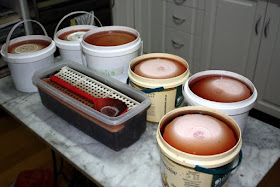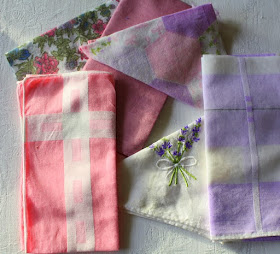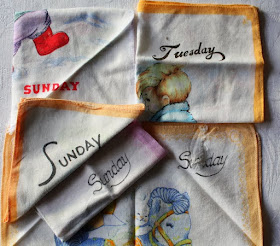To hankie or not to hankie,
That is the question.
Once upon a time it was never a feared object but it seems to be slipping into obsolescence.
When you have a cold and blow your nose there are typically many viruses that may be found. There is still debate about how long these viruses can live outside of the body, some say days and others a few hours. If nasal secretions get onto our hands they can then be passed to others by touching everyday objects like door knobs, light switches, telephones etc. If you have watched a sneeze recorded on camera, slowed and macro then you will get an idea of the power and spray potential of the nose.
Best practice is to wash your hands after sneezing or blowing to remove and kill the viruses regardless of whether you are using tissue or cloth.
The
ABC Health and Wellbeing published an article citing as their source Professor Jack Gwaltney who says putting hankies into a normal wash is sufficient to kill viruses and washing at high temperatures is not necessary. Your nasal secretions are natural bodily fluids and water soluble.
So good hygiene obviously is key and that includes disposing of tissues and washing used handkerchiefs.
Rebecca Blackburn also wrote an article
Tissues Vs Handkerchiefs in which she lays out all the number crunching on environmental impacts from both sides. At the time of her writing the article, Australians were using 273 000 tonnes of tissue products mostly all from virgin fibre. She based her calculations on a 1g tissue and a 15g cotton hanky assumed to be good for 520 uses.
It takes 2.2L of water to produce ONE tissue; that is four times as much as to produce 1 cotton hanky even though a huge amount of water is used to produce the cotton initially. It takes 165L to grow and produce one cotton hanky and a further 0.15L to wash but given that it is good for 520 washes, it's water footprint comes back to a mere 0.47L.
As far as energy goes, it takes about the same amount to produce a single tissue from virgin pulp as it does to produce and launder a cotton hanky 520 times.
As far as waste goes, tissues produce about 1.3g of waste including manufacturing waste. Hankies produce about 0.05g mostly from coal mining waste created to produce the energy needed to wash the hankies.
So the humble hankie wins on all accounts on the energy debate and I can think of better things to do with virgin fibres. As far as hygiene goes I think we have also busted some of those myths too. It is perfectly OK to use a handkerchief and wash it normally, no tricks or hoops jumped.
As you can see, I have a large hankie collection. They are much kinder on the nose and a beautiful accessory. I always believe a true gentleman always carries a hankie and can be relied upon to assist a lady in distress.
They wipe hands and brows as well as eyes and noses.
They dust seats or wipe spills.
They carry money tied up in the corner.
They are tucked in sleeves as well as pockets.
The white man's hankie above with the letter "A" belonged to a dear friend and it was all that I wanted after he died as a token.
The little square folded purple one is my newest. Mum brought it back from France for me.
These are perhaps my oldest personally owned. They always remind me of another dear elderly friend of my grandparents. His name was Peter and he owned Mellicks store and drapery at Longreach in QLD. I felt so grown up when he gave me beautiful boxed handkerchief sets, not like the childish ones in the photo above with drawings on them and days of the week. They were the ones I would take to Mass on Sundays, not for school, too precious!
The child's hankies in the photo earlier are the remnants of a number of sets my children had and isn't it interesting that we have four "Sundays" and a "Tuesday" left.
And still I use them....
Like these precious one that family members have made. Hand embroidered and crocheted edges.
Some handkerchiefs are works of art and some are exquisite examples of lace making and cut work.
Some have frayed hems but they are the softest of all.
They can be used as air filters like when people tied them around their noses and mouths fighting fires.
They are emergency bandages for cuts and grazes.
They are personal coolers; dampened and worn around the neck or around the wrist on pulse points.
Remember when they were also used as "hats" upon the head with a knot tied at each corner?
So what are your memories? Do you still use Hankies? Do you remember wrapping one of your precious baby teeth up at school in your hankie to take it safely home for under the pillow that night?

















































